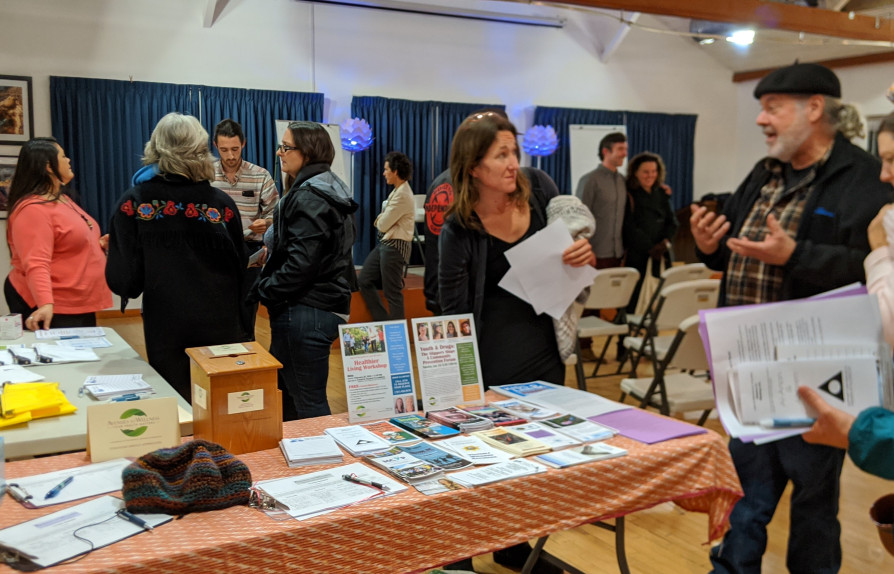Community Prevention Forum addresses local youth and drug use


Did you know that the number of youth who die of a drug overdose has almost tripled in the last 15 years? In Mendocino County, the rates are among the highest in the state at approximately 20 drug overdose deaths per 100,000 people, which is nearly four times the national average. The overuse of opioids has become so rampant, it has been given its own name – Opiate Use Disorder. It’s now defined as a chronic medical illness, like diabetes or heart disease.
Last week on Jan. 14 Avenues to Wellness, a program of the Frank R. Howard Foundation, hosted a community conversation to address some of issues surrounding youth and drugs. Local doctor Andrea McCullough MD, Mendocino County Youth Project program manager Aurelie Clivaz, Mendocino County Public Health program specialist Buffey Wright Bourassa and recovering addict Andrew Thomas formed a panel of experts who share their insight on the subject.
Thomas talked about his personal experience with drugs and alcohol as a youth, and his story of recovery from opioid use. “My life today doesn’t resemble the way things were 10 years ago, or 15 years ago, or even five years ago,” said the college graduate. Thomas said the outward appearance of his life “looked normal” because his parents were still married, his family was great, he got into a good school, and he had relationships, a place to live and a job. Since he had all that, he said he thought those things disqualified him from being a drug addict. “I thought that I partied, but so did everybody else… It seemed innocent enough.” After years of abuse, and going in and out of jail and rehab programs, he was finally able to get clean. “It’s probably more accurate to describe me as a sick person than a bad one.”
McCullough used her time to discuss contributing factors that lead to youth drug use. She said that aside from having a genetic disposition, youth may not have any risk factors at all and still “get turned on to drugs or alcohol and end up with a substance use problem.” She told the audience that all people have a “hole” inside them that wants to be filled with something, whether it be spiritual, a serotonin/dopamine craving, or something else. “I think that’s a really big part for any of use that that can lead to substance abuse… I think that getting to kids at an early age and finding something that floats their boat, something else that keeps them excited to get up in the morning, is a really great way to start.” She also said that she thinks neglect and abuse are big factors in the youth drug epidemic. “We are very, very busy in this culture and some of our parents are working two to three jobs at a time and they’re not home very much. That’s another big risk factor for drug and alcohol use.” She urged the audience to make time for family time so teenagers can have a “voice of reason” in their lives.
Wright Bourassa said told those in attendance that the county is “trying to attack this opioid epidemic in our county in all kinds of aspects. We are trying to manage and treat and save people’s lives… That’s a huge job and I can’t do it by myself… So, we need community support in this.” She said she focuses her work on helping youth at local schools learn how to make good choices on a daily basis. Recently she volunteered to start an Interact Club at Willits High School and hopes to use it as a platform to benefit the community. As a mother herself, she stressed the importance of having daily conversations with her children so she knows what is going on in their lives. “Our community really does have protective factors in place but it’s a matter of us stepping up and supporting these things and taking time out of our busy days to continue working with one another… I find it really important also to be open and honest with the youth that I work with and have found myself getting information that I wouldn’t normally have gotten.”
In Clivaz’s opinion, a major factor in the current drug crisis is that through social media, youth have easier access to the stresses of the world. “Kids are really tracking that stuff way more than we even realize. And, honestly, they are kind of the raw form of it… They’re the raw expression of the symptoms of our culture so if they’re showing up with drug addiction and not being able to deal with feelings, cope with stress, manage life, time management, that’s because we as a community are lacking in that way… The most important thing that I’ve learned through my journey working with young people is that they want to have a place to belong and they want to have something they’re good at… Those are actually the building blocks for self-esteem.”
Clivaz shared two handouts, one directed toward people who work with youth titled “Ways to Support Resilience in Youth” and another with similar advice about how an individual can practice being resilient throughout life. Some of the suggestions about how adults can support youth include being a healthy and grounded adult that models self-care, helping youth think through their problems, having non-shaming/non-judgmental conversations, and learning to recognize trauma and stress.
 Pathways Drug Rehabilitation Luxury Addiction Treatment & Detox Center
Pathways Drug Rehabilitation Luxury Addiction Treatment & Detox Center


